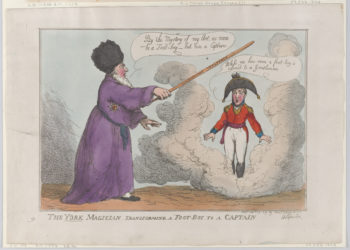The basic tension in scholarly publishing today is between researchers, who largely seek to publish in venues supported by the scholarly sub-community they aspire to, and funding agencies and libraries that see these “prestige” journals as a huge, wasteful tax on their operations. Publishers navigate these perilous waters by appealing, on one hand, to the desires of the authors, while at the same time identifying ways to monetize those aspirations. This has stimulated a new look at the most prestigious brands, with their incomparable ability to solicit a huge number of manuscript submissions. Publishers have learned that the sheer volume of these submissions can be used to offset some of the pressures brought about by funder mandates and the stated objectives of many academic libraries. It continues to befuddle me that so many proposed changes to scholarly publishing do not begin with the interests of the researchers themselves, which skew toward high-impact tribalism.
Here, a look back at a 2015 post that predicted much of the current situation.
Return of the Big Brands: How Legacy Publishers Will Coopt Open Access
With Open Access (OA) Week soon to be upon us, this seems like a good time to review how the OA world has evolved and where it is going. By my count we are well along in the third phase of open access publishing, with phase four rapidly coming into view. Of course, not everybody will accept a four-part typology, and they shouldn’t. Perhaps there are five stages, or ten. Or perhaps there is but one, which is continuously and inexorably unfolding. Call this the Calvinist Corollary: research literature that is free and accessible to one and all was predestined when God created the world. Her plan could be seen even in the earliest eukaryotic cells if only one looked closely enough. From this vantage, advocates of subscription-based publishing models seem to be walking on their knuckles while the upright Citizens of the International Research Community lead us to the fulfillment of Her plan. Typologies reflect a worldview, and mine is simply that tools are useful when they further our understanding and should be tossed out when they do not. I am prepared to jettison this taxonomy the moment Stage Five swims into view.

Meanwhile, those of us who have not caught the idealist contagion observe that things have changed since Stevan Harnad first nailed his “subversive proposal” to the church door. Harnad, in my view, belongs to the first stage, the Age of the Activists, who got the ball rolling. The Activists were idealists who saw in digital technology a means to subvert the restrictions of what they termed “toll-access publishing,” a form of publishing (so they argued) that was based on the scarcity model of print. Now, this is entirely untrue (publishing has nothing to do with paper), but it matters little: innovations can take place as much by misreading precedents as by understanding them in all their nuances. Right or wrong, the Activists won and we now live and work in a world significantly altered by them. Unsurprisingly, the Activist perspective caught fire in libraries, where open access was seen as a means to offset the growing market dominance of a handful of scholarly publishers. Unacknowledged then and now in library circles is that a fully OA universe is one without libraries.
The Activists gave rise to Stage Two, which I will call the Reign of the New Golden Rule. The new rule: He who has the gold makes the rules. Perhaps the “he” is a moral atavism (this wisecrack is a commonplace in Silicon Valley, gender bias and all), but it can be understood to refer to the community of funding agencies, which has taken up the cause of OA with a vengeance. I must say I never saw this coming. I would have thought that the funding bodies would have preferred to invest in research rather than the remaking of the publishing enterprise, but OA, even in or especially in its Gold variety, serves the funders well, as it brands content derived from their research dollars with their own imprimatur. The New Golden Rule transforms research publishing into content marketing. There is nothing wrong with content marketing, I hasten to add, but it’s not a bad idea to call it what it is.
We are well into Stage Three now, where the very publishers that were the target of the Activists in Stage One are coopting Gold OA. The logic of this is simple: funding agencies, seeking to promote their own activities, put money aside for Gold OA, and commercial organizations, whether for-profit or not-for-profit, develop services to capture that money. The cooptation can be seen in the sheer number of Gold OA services extant today and the downward pressure on PLOS’s output. Perhaps the best way to think of Gold OA is as a safety valve for the growing number of articles that exceed the limits of the acquisition budgets of cash-strapped libraries. Gold OA, that is, rather than disrupting the business models of toll-access publishers has evolved into an additive revenue stream. We have not come to the end of this phase.
Stage Four is a reassertion of some of the dominant brands in scholarly communications that had seen themselves being eclipsed by several recent developments — developments such as the Big Deal; the advent of Activist OA, which makes a case for the death of the journal and the emergence of the “article economy;” a focus on dissemination over accreditation; and the growing interest in altmetrics. Looking for a way to leap once again to their formerly dominant position, these brands scour their own operations looking for new opportunities and hidden assets. At some point they land upon on that peculiar asset, if “asset” is the right term: the huge number of articles turned down by their editors.
Let’s imagine a brand that turns down 70 out of every 100 submissions or an even more exclusive brand that turns down 80 — not to mention the elite of the elite, which accepts under 10% of all submissions for publication. It’s one of the nuttier things about the academy and scholarly communications (the Activists are dead right about this) that prestige is a function of how often you say no. But saying no, keeping the gates closed to all but a few, is an expensive operation. A journal that says no incurs a cost for managing the many stages of editorial review. If only 10% of the submitted articles are eventually published, it could be said that 90% of the cost of the editorial operation is wasted. The business challenge is how to accept more of the submitted manuscripts without undermining the prestige of the journal, not to mention the pride of those who edit it.
Thus we have the cascading model: articles rejected by the editors of the big brand-name journal are directed to other publications in the same family. This cascade can be to toll-access publications (the shining example is the line extension of the Nature Publishing Group) or to OA venues that exist to soak up the funding from OA mandates. The toll-access variant is challenged, however, by the limitations of library budgets. It just may be that no one is going to be able to emulate Nature, as Nature got there first (the value of strategic vision) before libraries were sidelined as publishing growth markets. Thus practitioners of the cascading model are likely to move to the Gold OA model. An important publishing question they will have to answer is whether they should create a single “megajournal” service or a portfolio of vertical services for the various subdisciplines covered in the parent publication. Whatever that decision, all these OA venues will use a variant of the conspicuous brand of the parent.
On the back of an envelope we perform these calculations. Our big brand journal publishes 1,000 articles each year in its founding toll-access publication. The acceptance rate is 10%. A cascading OA venue takes in another 20% or 2,000 articles, each of which bears an APC of $3,000 (APCs vary wildly, of course). That yields an incremental $6 million in revenue, and it’s high-margin revenue to boot, as many of the costs of producing the OA publication were already incurred when the articles were submitted to the parent journal in the first place. Thus OA publishing is to be embraced by established publishers because it provides a new, profitable revenue stream. The challenge for legacy publishers with OA has always been to separate the financially irresponsible rhetoric of the Activists from the underlying economics of mandated publication and a line in a research budget to pay for it.
I am calling this the return of the big brands (with apologies to George Lucas and his Star Wars saga) because the small number of elite journals with far more submissions than they can possibly handle in their toll-access flagship can use this cascading model to reassert themselves in the marketplace. This is not an issue that these journals are unaware of; the editors are seeing the second tier of journals getting stronger. Anurag Acharya, who runs Google Scholar, made this point on the Kitchen in a comment on John Sacks’s recent post. Apparently research publication is becoming more “democratic” in that more highly cited articles are appearing in non-elite journals, but the reason for this is not the democratizing nature of the Internet (assuming the Internet has any such property) but the fact that the legacy brands have mostly kept their gates closed. Open the gates and the submissions and the number of publications to and by the big brands will explode.
Fast-forward five years and we see more and more legacy publications adopting this Stage Four strategy. The brands will increasingly see themselves as brands and not merely as editorial properties; they will strive to increase their submissions. The parent publication will spawn families of affiliated publications, most of them working with the Gold OA model. Libraries will continue to purchase large aggregations, though from fewer and fewer publishers; and funding bodies will continue to build the market for mandated OA publication with attendant APCs (simultaneously and causally reducing the amount of money that goes toward research). Library publishing will suffer as more authors migrate to the branded OA services. The publishing market for scholarly material will grow.
As for whether this is an utopian or dystopian vision, I cannot provide an answer, as calculating good and evil is not my line of work. But the Star Wars films support competing interpretations. Perhaps we should not be celebrating the return of the Jedi but mourning that the empire strikes back.



